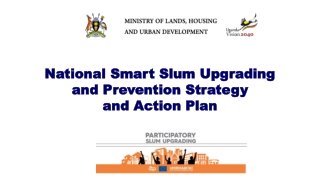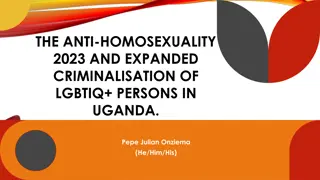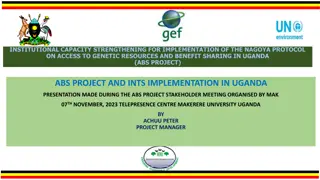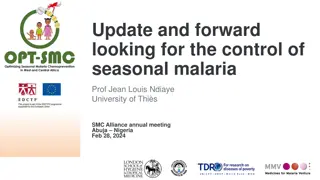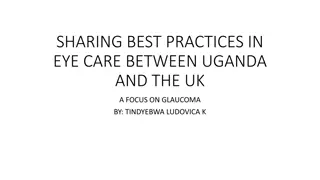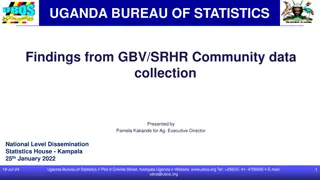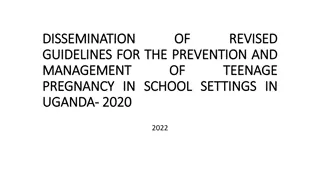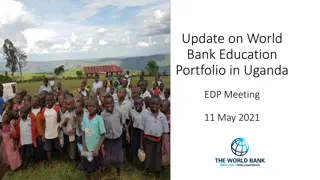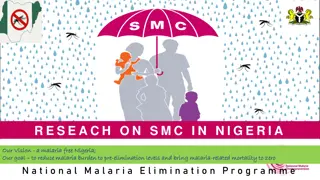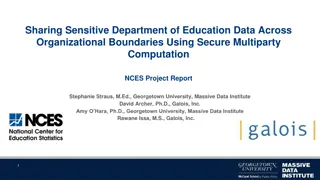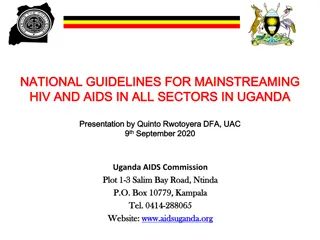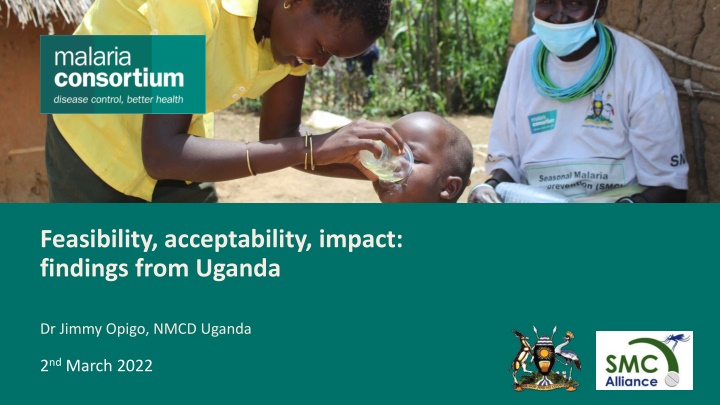
Feasibility, Acceptability, and Impact of SMC with SPAQ in Uganda: Study Findings
Discover the feasibility, acceptability, and impact of Seasonal Malaria Chemoprevention (SMC) with Sulfadoxine-Pyrimethamine+Amodiaquine (SPAQ) in Uganda, based on a study conducted in Karamoja region. Results show high community acceptance, safety, and effectiveness of the program, with significant reductions in malaria cases among children.
Download Presentation

Please find below an Image/Link to download the presentation.
The content on the website is provided AS IS for your information and personal use only. It may not be sold, licensed, or shared on other websites without obtaining consent from the author. If you encounter any issues during the download, it is possible that the publisher has removed the file from their server.
You are allowed to download the files provided on this website for personal or commercial use, subject to the condition that they are used lawfully. All files are the property of their respective owners.
The content on the website is provided AS IS for your information and personal use only. It may not be sold, licensed, or shared on other websites without obtaining consent from the author.
E N D
Presentation Transcript
Feasibility, acceptability, impact: findings from Uganda Dr Jimmy Opigo, NMCD Uganda 2ndMarch 2022
Background The Uganda Malaria Reduction and Elimination Strategic Plan 2021 2025 proposes new, innovative chemoprevention approaches progress towards malaria elimination. to accelerate Modelling conducted by the Swiss Tropical and Public Health Institute suggests that SMC could be a viable malaria prevention strategy in the northeastern Karamoja region. Karamoja has consistently reported the highest prevalence rates in transmission is seasonal. the country; malaria Resistance to SP is assumed to be high.
SMC implementation study 2021 The National Malaria Control Division and Malaria Consortium conducted an SMC implementation study in two districts of Karamoja. A third district with no SMC served as a comparator. The target population of children 3-59 months was 90,000. Five SMC cycles with SPAQ were implemented between May and September. Village Health Teams acted as SMC community distributors.
Study components Study component Outcome measure Participants and sample size 1. End-of-round household survey Coverage, quality of SMC implementation 1,863 caregivers of children 3-116 months 2. Key-informant interviews (KIIs) and focus group discussions (FGDs) Acceptability among key stakeholders 51 KIIs and 26 FGDs with caregivers, community leaders, community distributors, health authorities 2. Non-randomised controlled trial (prospective cohort study) Clinical malaria episodes among SMC-eligible children during the peak transmission season 396 children who had received SMC in intervention district vs. 199 children who had not received SMC in control district 3. Resistance markers study Prevalence of common SP and AQ resistance markers before and after SMC implementation 300 children 3-59 months (approximately 150 before and 150 after annual SMC round)
Results: acceptability and feasibility SMC with SPAQ was found to be safe, feasible and acceptable in the local context. High coverage was achieved, comparable with coverage rates typically found in the Sahel. The community is very grateful. They also rush whenever they hear about the supply of SPAQ. Honestly, the community has responded very well and they love the programme Results from an end-of Round household survey (n=1587) showed that 96.8% of eligible children received Day 1 SPAQ as DOT. Community leader Among children who received Day 1 SPAQ, 99.6% then received the full three-day course of SPAQ.
Results: effectiveness Children in intervention districts had a 92.2 percent lower risk of developing confirmed malaria in the five-month follow-up versus those in the control Confirmed malaria cases Person time of observation (months) Incidence rate Intervention 60 1,982 0.03 Control 387 997 0.3382 Incidence rate ratio: 0.078 (95% CI: 0.063 0.096, p<0.0001) Protective effect size: 92.2% (1 0.078)
Results: effectiveness In the intervention areas 90 percent of children never experienced a malaria episode, versus 15 percent in the control area; 85 percent of children in the control developed at least one episode and 60 percent had at least two over the follow-up period
Next steps Resistance markers study results are not yet available. We plan to conduct further research in 2022, involving SMC delivery in 5 districts and targeting 135,000 children. Phase 2 of the study will gather more robust evidence of the effectiveness of SMC through cluster-randomised controlled trial. We will also conduct a chemoprevention efficacy cohort study. The study design will be very similar to the research that is currently being conducted in Mozambique, including continued monitoring of resistance markers. We plan to test SMC using dihydroartemisinin-piperaquine (DP) as well as SPAQ. Global Fund will support SMC in three additional districts in Karamoja (90,000 children)
Click to add text Click to add text Click to add text Click to add text Click to add text Thank you www.malariaconsortium.org www.malariaconsortium.org/smc Thank you

